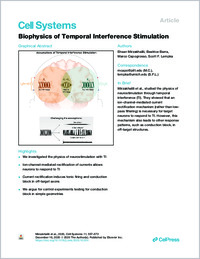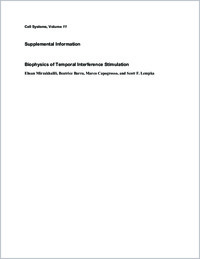Biophysics of temporal interference stimulation
- Mirzakhalili, Ehsan Department of Biomedical Engineering, University of Michigan, Ann Arbor, MI 48109, USA - Biointerfaces Institute, University of Michigan, Ann Arbor, MI 48109, USA
- Barra, Beatrice Department of Neuroscience and Movement Science, University of Fribourg, Fribourg, Switzerland - Rehab and Neural Engineering Labs, University of Pittsburgh, Pittsburgh, PA 15213, USA
- Capogrosso, Marco Rehab and Neural Engineering Labs, University of Pittsburgh, Pittsburgh, PA 15213, USA - Department of Neurological Surgery, University of Pittsburgh, Pittsburgh, PA 15213, USA - Department of Bioengineering, University of Pittsburgh, Pittsburgh, PA 15213, USA -
- Lempka, Scott F. Department of Biomedical Engineering, University of Michigan, Ann Arbor, MI 48109, USA - Biointerfaces Institute, University of Michigan, Ann Arbor, MI 48109, USA - Department of Anesthesiology, University of Michigan, Ann Arbor, MI 48109, USA -
-
16.12.2020
Published in:
- Cell Systems. - 2020, vol. 11, no. 6, p. 557-572.e5
temporal interference
inferential stimulation
intersectional pulsed stimulation
transcranial electric stimulation
transcranial direct current stimulation
transcranial magnetic stimulation
deep brain stimulation
spinal cord stimulation
neuromodulation
computer simulation
English
Temporal interference (TI) is a non-invasive neurostimulation technique that utilizes high-frequency external electric fields to stimulate deep neuronal structures without affecting superficial, off-target structures. TI represents a potential breakthrough for treating conditions, such as Parkinson’s disease and chronic pain. However, early clinical work on TI stimulation was met with mixed outcomes challenging its fundamental mechanisms and applications. Here, we apply established physics to study the mechanisms of TI with the goal of optimizing it for clinical use. We argue that TI stimulation cannot work via passive membrane filtering, as previously hypothesized. Instead, TI stimulation requires an ion-channel mediated signal rectification process. Unfortunately, this mechanism is also responsible for high- frequency conduction block in off-target tissues, thus challenging clinical applications of TI. In consequence, we propose a set of experimental controls that should be performed in future experiments to refine our understanding and practice of TI stimulation
- Faculty
- Faculté des sciences et de médecine
- Department
- Département de Médecine
- Language
-
- English
- Classification
- Biological sciences
- License
-
License undefined
- Identifiers
-
- RERO DOC 329929
- DOI 10.1016/j.cels.2020.10.004
- Persistent URL
- https://folia.unifr.ch/unifr/documents/309379
Other files
Statistics
Document views: 189
File downloads:
- pdf: 400
- Supplementary material: 200

